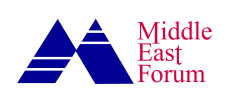|
|
Sirwan Kajjo, writing fellow for the Middle East Forum, journalist, researcher, author, and broadcaster on the Voice of America (VOA), spoke to a July 21st Middle East Forum Webinar (video) about the role of U.S. forces in war-torn and fractured Syria, “where everybody is vying for control.” The following is a summary of his comments:
The Syrian Civil War erupted in southern Syria in 2011 following protests against the regime that spread to the entire country. Today Syria experiences “low-intensity conflicts” between “multiple local groups on the ground that support either regional or foreign powers.” Currently, for example, there are two zones of influence in Syria’s Deir ez-Zur province, which is bisected by the Euphrates River. The U.S., which has been fighting ISIS in Syria since 2014, currently has nine hundred U.S. troops in the de facto Autonomous Administration of North and East Syria (AANES). These troops work with the U.S.-backed Syrian Democratic Forces (SDF), a Kurdish-led group that has been partnering with the U.S. in the fight against ISIS terrorism.
The U.S. military presence has minimized the Syrian regime’s influence in the AANES region, but Kurdish officials are still stymied by the “lack of political independence from Damascus.” The two regions cannot be economically separated. The Syrian Pound (SYP) currency is still used in the northeast region and AANES still relies on certain regime policies. Although many international non-governmental organizations (NGOs) are pumping money into the local economy and providing an indirect source of investment in the AANES, the northeast region is not fully independent of the Assad regime.
Turkish-backed Syrian militias along the Turkish/Syrian border and al-Qaeda (AQ) affiliates in the northwest also maintain areas of control. The remainder of Syria is controlled by the Russian and Iranian-supported government troops of Assad’s regime. Syria’s “chaotic” environment was further complicated in 2019 when Turkey launched its third offensive after the Trump administration partially withdrew U.S. troops and thereby adversely affected the “security equation” in Syria.
Turkey, the U.S., and the European Union have designated the Kurdish PKK (Turkish-based Kurdistan Workers Party) as a foreign terrorist organization. Turkey, a “major regional power,” is the largest investor in Kurdistan (Kurdistan Regional Government), the autonomous region in Iraq’s “federal system” that emerged after Iraq was liberated in 2003. As the PKK’s presence is “marginalized” in Iraqi Kurdistan, Turkish president Erdoğan can promote his AKP party’s version of political Islam there. The Kurds in Turkey, “the largest concentration of Kurds in the Middle East,” have managed only to control southeastern municipalities in the Kurdish-majority provinces of Turkey, but have no autonomy. Familial ties between Kurds in Syria and Turkey connect the two communities.
Erdoğan “doesn’t distinguish between Kurds,” even though the PKK constitutes “only a small portion of Kurdish society.” Since 2016, Erdoğan has launched drone attacks against the SDF and the Kurdish People’s Protection Units (YPG) — groups that are fully distinct from the PKK. The attacks, which cause significant civilian casualties and inflame an already volatile situation, place the U.S. in the middle of a difficult problem. Although the Kurds are a “reliable” ally, America also relies on Turkey as a NATO member to carry out U.S. policy on certain issues in the Middle East.
Even though America provides military support, the pro-Western Kurds in AANES are hesitant to fully rely on the U.S., in part because it provides only partial political support. Syria’s Kurds see the two as “interconnected,” particularly because of the natural alliance they share with the U.S. “We have proven to be pro-American ... we’ve established a governing system that adheres to Western ideals and Western values.” Russia’s and Iran’s aim is to oust America from the region. As a counterweight, the Kurds support America’s strategic interests in the Middle East, in particular America’s fight against ISIS and Washington’s mission to maintain stability in north-east Syria. The SDF and “its Kurdish groups at large in northern Syria” have proven over the past decade that it is “the only entity ... to provide a vision for the future of Syria.”
The Kurds support America’s strategic interests in the Middle East, in particular America’s fight against ISIS and Washington’s mission to maintain stability in north-east Syria.
The different areas of control are widely divergent in their forms of governance and outlook. Russia and Iran in the regime-controlled areas benefit from regional instability and rely on the drug trade as a source of income. “Other militias affiliated with the Iranians and the Syrian government have been benefiting from [the drug trade] in the past few years, largely because of this unstable situation in parts of Southern Syria and areas along the border with Lebanon.” The Turkish and Sunni Islamist-controlled area in the northwest claims to be “different from everything else that we’ve seen in the context of Global Jihad . . . a Syrian nationalist movement that also happens to be Islamist.” The AQ affiliates enforce strict Sharia in their area of control. The Kurds in the AANES, where the U.S. maintains security and stability, have built a civilian administration.
Kajjo recommends the U.S. pursue a twofold policy that would serve both American strategic interests and Kurdish aspirations: (1) Support the SDF and the YPG in their fight against ISIS; and (2) support Kurdish groups in their efforts to build a “pluralistic” society for their diverse population and maintain a system of good governance, all of which would enable the disparate groups residing in the AANES to thrive.





